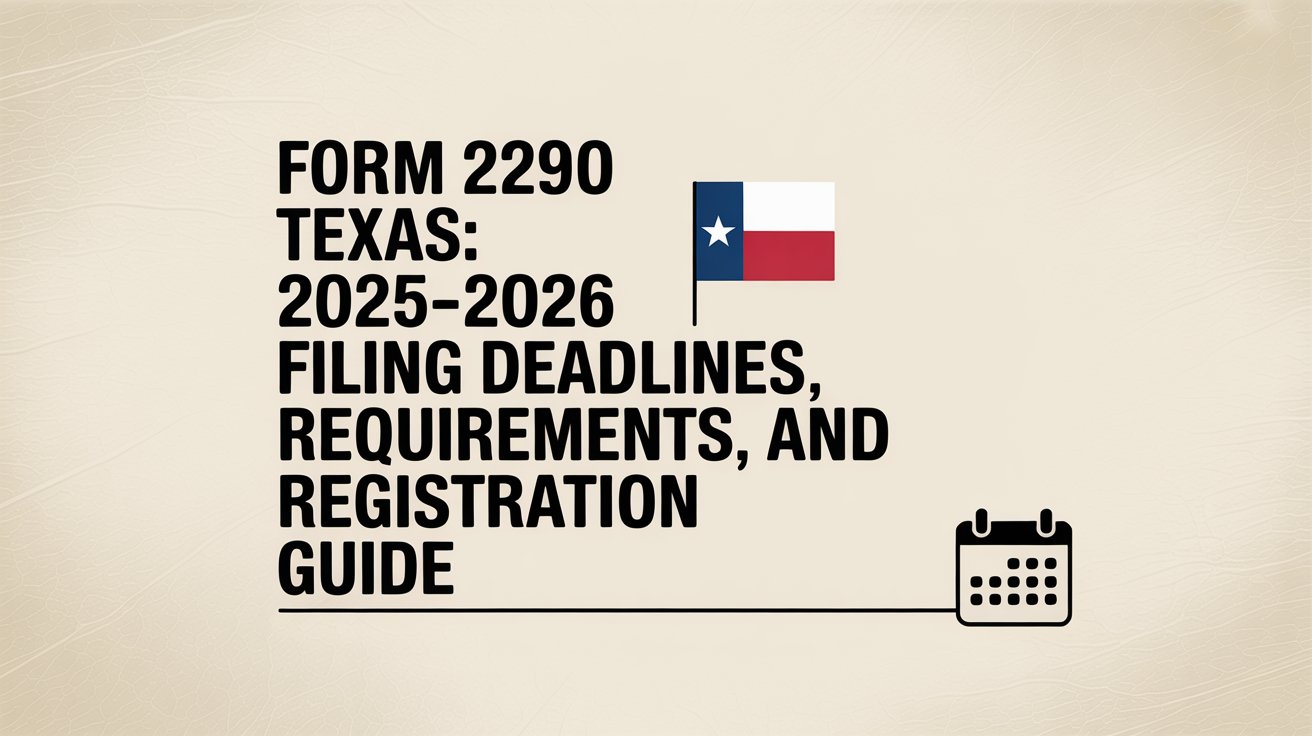Form 2290 Texas: 2025–2026 Filing Deadlines, Requirements, and Registration Guide

When it comes to operating a heavy vehicle in Texas, compliance with federal tax laws is just as important as keeping up with state registration rules. One requirement that every trucker or fleet owner needs to know is Form 2290 Texas, the Heavy Highway Vehicle Use Tax (HVUT) return. This article explains what Form 2290 is, how it works specifically in Texas, when it is due, and how to stay compliant with both IRS and Texas Department of Motor Vehicles (TxDMV) rules.
What Is Form 2290?
Form 2290 is the annual federal tax return used to report and pay the Heavy Highway Vehicle Use Tax. This tax applies to trucks, tractors, and buses that have a taxable gross weight of 55,000 pounds or more and operate on public highways. The funds collected are primarily used to maintain and repair the nation’s roads and highways.
For Texas truckers, filing Form 2290 Texas is essential because proof of payment, known as the Schedule 1, is required to title, register, or renew apportioned vehicles with the TxDMV. Without it, you cannot legally register your truck for use on Texas highways.
Why Texas Truckers Must Pay Attention
Texas is home to one of the largest trucking industries in the United States. From long-haul interstate carriers to agricultural haulers, compliance with Form 2290 is a must. The TxDMV requires proof of HVUT payment within 60 days of titling or registering a new or used heavy vehicle. If you are an owner-operator or fleet manager, failing to provide this proof means delays in getting your trucks on the road legally.
2025–2026 Tax Year & Deadlines
The HVUT tax year runs from July 1, 2025, through June 30, 2026. For vehicles first used in July, the filing deadline is September 2, 2025 (since August 31 falls on a weekend and September 1 is Labor Day). For vehicles first used in other months, the due date is the last day of the following month.
For example:
- If your truck first hits the road in November 2025, your Form 2290 Texas is due December 31, 2025.
- If you add another truck in March 2026, the return and tax are due by April 30, 2026.
What You Need Before Filing
Before you sit down to file, gather these essentials:
- Employer Identification Number (EIN) – Required by the IRS; a Social Security number cannot be used.
- Business name and address – Must match IRS records exactly.
- Vehicle Identification Number (VIN) – For each taxable vehicle.
- Taxable gross weight – Determined by the truck’s weight plus maximum load.
- Mileage category – To identify whether your truck qualifies for suspended tax (e.g., agricultural or limited-use).
- Payment method – Options include Electronic Funds Withdrawal, EFTPS, debit/credit card, or mailed check.
Having this information ready ensures a smooth filing experience.
Filing Form 2290 Texas: Step-by-Step
1. Choose Filing Method
- E-file: Recommended and required if you are reporting 25 or more vehicles. You’ll receive your Schedule 1 almost instantly.
- Paper filing: Still available for smaller filers, but processing can take weeks.
2. Complete the Form
Enter your EIN, business details, VINs, weight categories, and tax calculation.
3. Pay the Tax
Select your payment option. Many truckers prefer EFTPS or debit/credit cards for speed.
4. Get Your Schedule 1
If you e-file, your stamped and watermarked Schedule 1 arrives within minutes. Paper filers will receive it by mail once the IRS processes the form.
5. Submit Proof to TxDMV
Provide Schedule 1 at your county tax office or to the TxDMV when registering or renewing apportioned plates.
Tax Rates and Categories
The HVUT tax is based on a vehicle’s weight and mileage use. Here’s the basic breakdown:
- 55,000 – 75,000 lbs: Tax rates range from $100 up to $550.
- Over 75,000 lbs: Flat annual tax of $550.
- Suspended vehicles: Trucks used fewer than 5,000 miles annually (7,500 for agricultural) may qualify for suspension.
Texas Registration and Schedule 1 Proof
In Texas, the Schedule 1 isn’t just a federal document—it’s your ticket to registration. Whether you’re applying for new apportioned plates or renewing under the International Registration Plan (IRP), you must present proof of HVUT payment.
If your Schedule 1 has errors—such as a VIN typo—file a correction immediately. Without an accurate Schedule 1, Texas officials will not process your registration.
Exemptions and Special Cases
Some vehicles may be exempt or qualify for suspended tax, including:
- Agricultural trucks operating under 7,500 miles annually.
- Low-mileage trucks that run less than 5,000 miles per year.
- Government-owned or non-profit organization vehicles.
Even if you qualify for suspension, you must still file Form 2290 Texas and check the “suspended” status box.
Common Texas Trucking Scenarios
- Buying a Truck Mid-Year: If you purchase and begin using a truck in February 2026, your Form 2290 is due by March 31, 2026.
- Increasing Vehicle Weight: If you upgrade equipment and your truck moves into a higher weight category, you must file an amended Form 2290 and pay the additional tax.
- Selling or Destroying a Vehicle: You may claim a credit for the unused portion of tax paid.
- VIN Correction: Mistyped VINs require you to file a correction to ensure your Schedule 1 matches your registration documents.
Penalties for Late Filing
The IRS imposes penalties if you file late or fail to pay. These can include:
- Penalty fee: Generally 4.5% of the total tax due per month, up to 5 months.
- Interest charges: Added to the unpaid balance.
- Additional TxDMV delays: You will not be able to register your vehicle until proof is provided.
Requesting penalty relief may be possible if you have a valid reason, but prevention is far easier than dealing with fines.
Texas Owner-Operators vs. Fleets
For owner-operators, the process is straightforward: file for your one truck, pay the tax, and present Schedule 1 to the county tax office.
For fleets, especially those with 25 or more vehicles, e-filing is mandatory. Having a structured workflow—such as using an IRS-approved e-file provider—saves time and ensures compliance across all trucks in the fleet.
Frequently Asked Questions
Is the 2025 deadline September 2?
Yes. Because August 31 falls on a weekend and September 1 is a holiday, the due date is September 2, 2025.
Can I register in Texas without Schedule 1?
No. TxDMV requires proof of HVUT payment for any heavy vehicle registration.
Do I need an EIN to file?
Yes. The IRS requires an Employer Identification Number to process Form 2290.
How soon will I get Schedule 1 if I e-file?
Within minutes of IRS acceptance.
Which payment method is fastest?
EFTPS or debit/credit card payments are fastest, especially if paired with e-filing.
Final Thoughts on Form 2290 Texas
Filing Form 2290 Texas is more than a federal requirement—it’s a necessary step for keeping your trucks legally registered with the TxDMV. With deadlines, weight categories, exemptions, and penalties to consider, staying informed and filing on time is essential.
Whether you’re an owner-operator with one truck or a fleet manager handling dozens, the process can be simplified with electronic filing. Always keep your Schedule 1 safe, double-check VINs, and make sure you meet Texas registration proof requirements. By doing so, you’ll avoid costly delays and keep your business moving down the road.
Do Read: Paul Mackoul MD Lawsuit: Legal Battle Over Surgical Practices, Ethics





